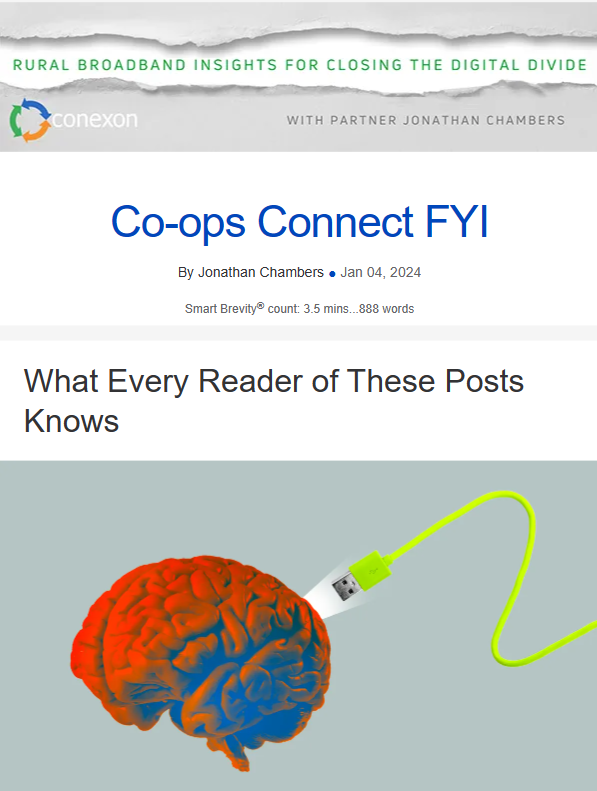What Every Reader of These Posts Knows
January 5, 2024
A new year’s note:
Californians’ energy bills will be higher in 2024. Pacific Gas & Electric (PG&E) is ringing in the new year with a spike in energy bills. Starting January 1, most households’ gas and electric bills will increase about 13%, according to PG&E’s press release.
A smaller new year’s note:
On January 2, I deposited a check of $655.10, my distribution from the Roaring Fork Valley Co-op in Colorado, where I am a member.
Why it matters:
The contrast between these two events is what virtually every reader of these posts knows — and what few others may understand.
- Members of electric cooperatives have enjoyed lower rates — while receiving better and more reliable electric service — than the rest of America since the birth of these co-ops in the late 1930s.
- The economic and social arrangement of private, member-owned electric distribution cooperatives was and remains superior to all other forms of electric distribution.
- For that matter, it is superior to constructing, operating, and maintaining large-scale infrastructure including broadband.
The Conexon Proposition
When Randy started Conexon and I joined him the following year, we committed to testing a proposition we believed deeply: That any location served by a co-op’s electric distribution line could be served by a fiber line.
The corollary to our proposition was:
We knew only one way to do it, which was to follow the model Randy developed at Co-Mo Connect.
Over the years, we have offered co-ops the Co-Mo Connect model as well as two variations of the same model:
- Electric co-op-owned and co-op-operated fiber infrastructure
- Electric co-op-owned, Conexon-operated fiber infrastructure
- Conexon-owned and Conexon-operated fiber infrastructure built in partnership with a co-op
Spoiler alert:
It worked.
More importantly, the Co-Mo Connect model was transferable from Missouri to other states, terrains, populations, and demographics.
- To Arkansas, then Virginia, then Oklahoma, Tennessee, Mississippi, then Georgia, Florida, Louisiana, Kentucky, and on and on and on.
- For those co-ops who chose to embrace the rural electrification model for broadband, success begat success.
What’s Next
And now, in 2024, here comes BEAD’s $42.5 billion in broadband grants. That will be $42.5 billion more in grant funding than was spent on the entire nation’s rural electrification.
Yet, with all this money for a single purpose at this time, one thing is certain: Government will not re-create the success of rural electrification.
- It will not spark the same broad movement of locally owned and maintained critical infrastructure.
- It will not do so because that is neither the intent nor the design of the BEAD program.
For broadband, local communities and geographic areas have been carved up:
- By incumbent ISPs
- By partial and inadequate state and federal programs
- By contradictory funding rules
- By inaccurate maps
The nation is so carved up that it is nearly impossible to form a cohesive community of interest around any local broadband geography.
Worse still:
The very government agencies charged with ensuring adequate broadband have often worked at cross purposes.
- The Rural Utilities Service, successor agency to the Rural Electrification Administration, stifles new businesses with regulation.
- The National Telecommunications and Information Administration, in administering the BEAD program, appears to have a more political agenda, which is at odds with rural broadband construction.
- The Federal Communications Commission, decades ago, was given the responsibility for ensuring that all rural areas have access to quality telecommunications services. Despite spending $100 billion of public money, it did not get the job done.
- State broadband offices, buffeted by state politics and hemmed in by NTIA rules, will neither be able to spend all the BEAD funding, nor close the rural digital divide.
The Final Word
Given the state and federal rules governing the BEAD program, I cannot see how it is possible for BEAD to result in fiber infrastructure to every rural home and business.
That said, there are important exceptions — those areas served by the exceptional electric cooperative community. I still believe it is possible for every electric cooperative to build fiber to every member.
BEAD is a fork in the road for every rural, underserved community. As Yogi Berra said, “When you come to a fork in the road, take it.” By that, he meant: Do something. Don’t perseverate at the fork trying to decide which way to go.
Put another way:
Give your community a chance to have the type of broadband service provided by OEC Fiber in Oklahoma or Firefly in Central Virginia or Connect in Central Georgia or by the scores of other electric co-op fiber providers.
Don’t be like PG&E. Don’t be like AT&T. Don’t be like cable.
Be like a co-op – it’s as relevant today as any time in the past 85 years.
A Personal Post Script
I took a break last year from writing and have decided to return to it. It helps me think.
I always start my writing process the same: I tell myself to write one true thing.
Today’s one true thing is this: It would be difficult for me to express adequately my gratitude to the many friends and colleagues for your support, well wishes, and prayers this past year.
Thank you.
